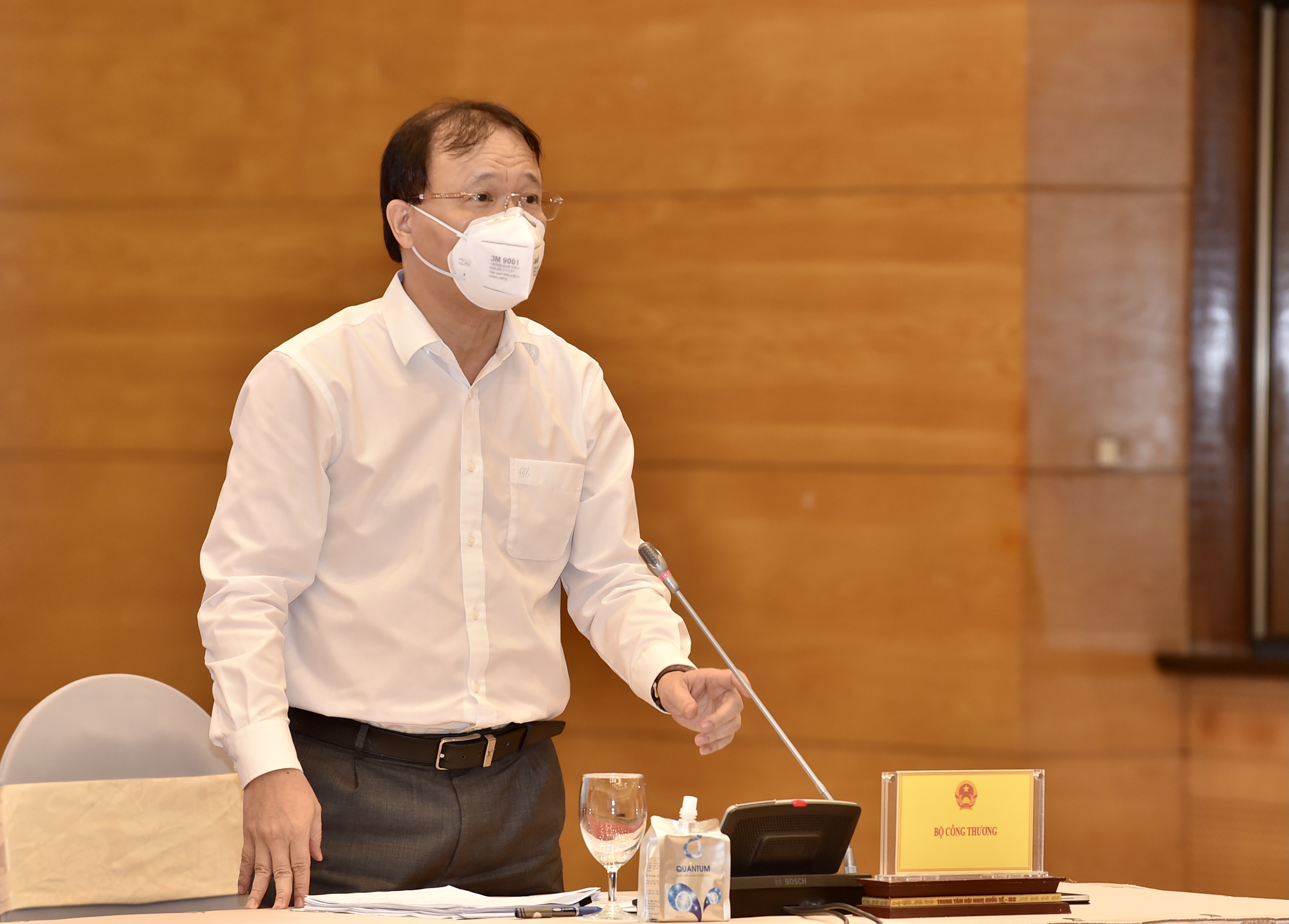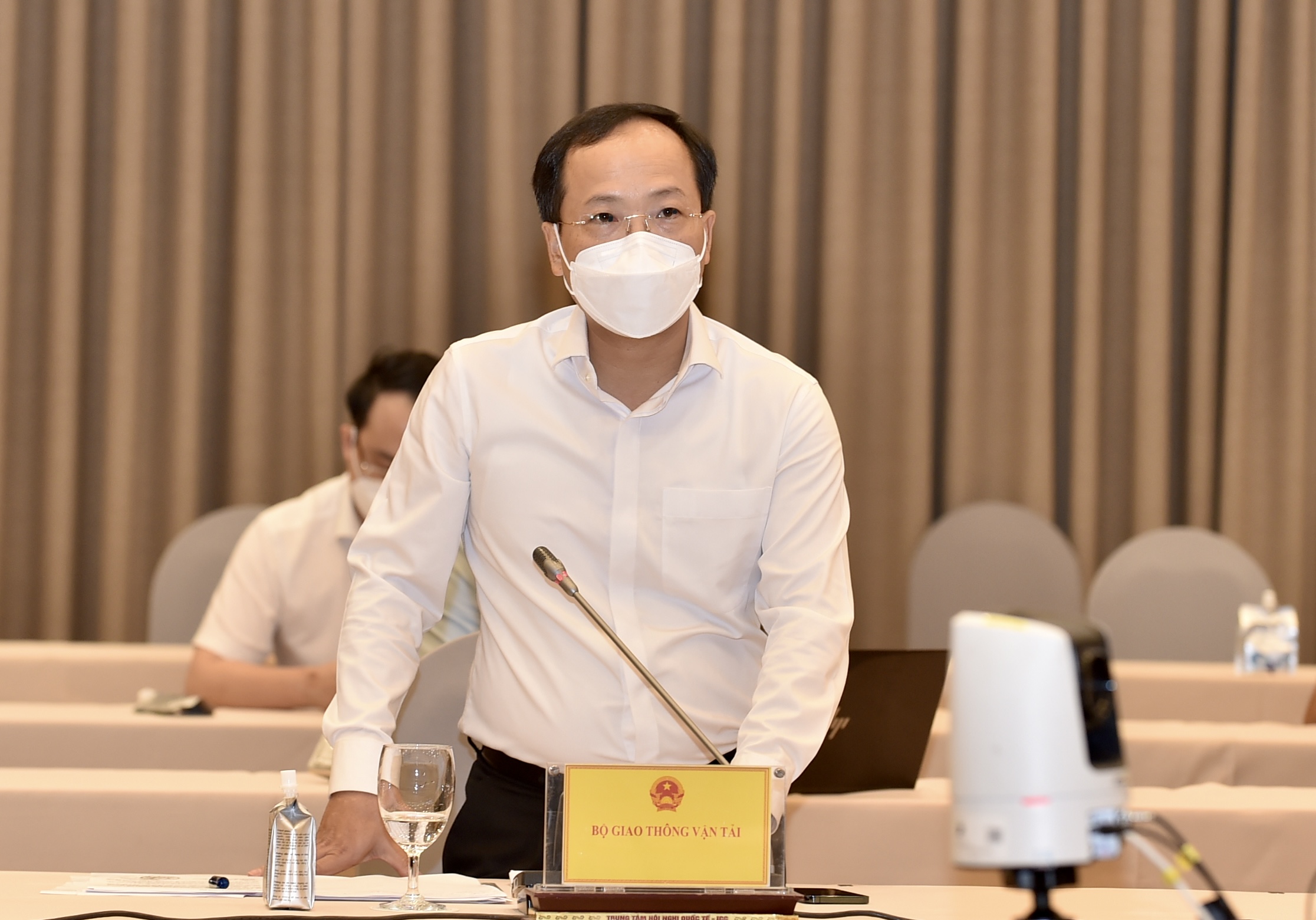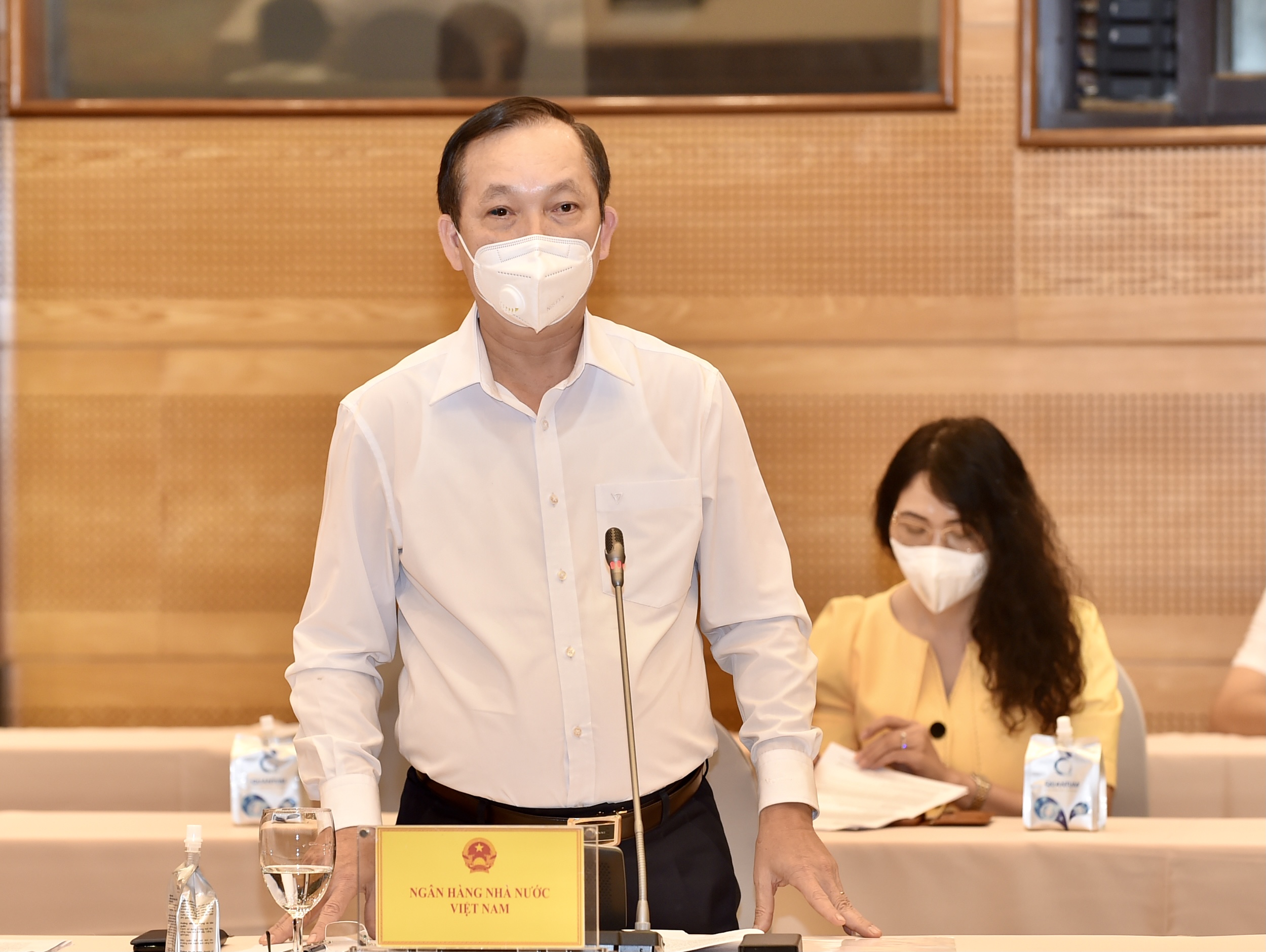Transcript: Government's press briefing - August 2021
VGP - The following is transcript of the Government's press briefing held on August 11, 2021 following the Cabinet meeting.
Vaccination, eliminating/tackling bottlenecks in goods circulation, solutions for supporting people and businesses... are among issues that draw attention from media at the Government’s Regular Press Conference for July.
Speakers:
- Deputy Minister of Finance Nguyen Duc Chi
- Deputy Minister of Health Tran Van Thuan
- Deputy Minister of Industry and Trade Do Thang Hai
- Deputy Minister of Transport Nguyen Duy Lam
- Deputy Governor of the State Bank Dao Minh Tu
Reporter: The fourth wave of COVID-19 has significantly damaged the economy and affected businesses. It is said that the Ministry of Finance has promptly submitted proposals to the Government in order to alleviate difficulties for businesses. Has the Government submitted this support/relief package to the National Assembly’s Standing Committee for approval; and which category of tax are subjected for exemption and reduction ?
At this point, the trading system of Ho Chi Minh Stock Exchange (HOSE) has become stable. When could transactions with the trading lot of 10-share be conducted, so as to protect the investors’ interests?
Deputy Minister of Finance Nguyen Duc Chi speaks at the press briefing. Photo: VGP
Deputy Minister of Finance Nguyen Duc Chi: The Ministry of Finance has directed the implementation of solutions so that transactions with the trading lot of 10-share can return as soon as possible in this August before increasing the lot size.

I have also just received a report from SSC’s Chairman informing that it is fairly tense the situation related to the outbreak in Ho Chi Minh City, where the Stock Exchange located.
There are even COVID-19 patients among the staffs at the Stock Exchange, so the conducting of system tests and demo transactions could be delayed. We shall try our best so that the trading system could immediately resume operations when the outbreak in Ho Chi Minh City is contained. Hopefully, with how the containment of the outbreak is progressing in the city, operations could be resumed in this August.
Regarding the upcoming policies, following resolutions and directions by the National Assembly on supporting enterprises, organizations and individuals those who facing difficulties due to the pandemic, the Government and the Prime Minister, as you may know, have approved extension for several policies that came into effect back in 2020, including the extension of deadlines for taxes and land lease payments, taxes and fees reductions/exemptions. In 2021, the total value of the relief package is estimated at VND118,000 billion (roughly US$5.17 billion). Aside from that, in accordance with the National Assembly’s Resolution, as well as directions from the Government and the Prime Minister, the Ministry of Finance has also reviewed and submitted several proposals to competent authorities for consideration and approval.
· Continuing to reduce the enterprise income taxes for small and medium-sized household businesses with total revenue of below VND 200 billion (USD 8.78 million) each; Reducing different types of taxes for food and beverage household businesses (applies to all forms of tax declarations) - we expect to reduce them by 50%.
Reducing VAT for businesses operating in fields severely affected by the pandemic such as transportation, accommodation, or tourism...
Exempting tax payments penalties for tax payers under difficult circumstances.
· Reducing land lease payments in 2021 for subjects under difficulties. The total estimated value of the support package proposed by the Ministry of Finance is VND 20,000 billion (US$876 million).
Regarding the process, we are now collecting opinions to report to ministries and sectors. Feedbacks from ministries and sectors then will be submitted to the Government so it can have overall information before being able to present the proposal to the National Assembly Standing Committee for consideration and approval at the upcoming meeting of the Committee.
Reporter: The COVID-19 pandemic situation is still complicated and witnesses widespread, but the vaccination is said to be quite slow. Can the Ministry of Health provide us the vaccination rate in Viet Nam, especially in two major cities of Ha Noi and Ho Chi Minh? Which solutions does MoH have for accelarating the vaccination?
Deputy Minister of Health Tran Van Thuan. Photo: VGP
Deputy Minister of Health Tran Van Thuan: Of the 18 million vaccine doses received, more than 11 million vaccine doses or 65% of the supplied doses have been administrated throughout the country.

Currently, the total number of vaccines doses supplied to Ho Chi Minh City is 4,075,270. The city has administrated 3,598,687 doses (88.2%). Within August 11th and August 12th, the city will administrate the remaining doses. At the same time, the city is expected to carry out the vacination with other vaccines such as Sinopharm.
Regarding Ha Noi: To date, the city has received 2,944,910 vaccine doses with 1,5 million administrated (approx 50%). In the upcoming time, Ha Noi shall also accelerate the vaccination.
In order to speed up vaccination in Ha Noi, HCMC as well as in other localities, the ministry has instructed provinces and cities to draw up specific plans, with detailed estimations for monthly vaccine distributions, so that the vaccination campaigns can be carried out in a more proactively manner.
The ministry has also sent official documents asking provinces and cities to urgently administrate the supplied doses; noting that if any locality fails to avoid having backlogs of vaccines, the doses allocated to that locality would be transferred to another one. After several documents like these, the vaccination in provinces and cities shows improvement.
Nevertheless, the ministry’s stance is that vaccination has to be both quick and safe, ensuring safety in every jab. Because of this, the preparation work is scrupulously conducted, especially when it comes to medical equipment, medicines, mobile vaccination vehicles and medical facilities. In the upcoming time, when more vaccines arrive in Viet Nam, the ministry shall continue to accelerate the vaccination work. With the coordination between the healthcare sector and the armed forces, the total number of vaccine jabs per day could reach up to 2 million.
Reporter: At the moment, businesses are facing difficulties as they have to comply with anti-pandemic measures while also have to contribute to economic development, which involving circulating goods. What are the solutions for eliminating obstacles in goods circulation?
I would also like to ask the Ministry of Finance and the State Bank of Viet Nam about measures to tackle difficulties in loan interest rates for people and businesses.
Deputy Minister of Industry and Trade Do Thang Hai. Photo: VGP
Deputy Minister of Industry and Trade Do Thang Hai: As you may know, the Government, ministries and sectors have issued many documents guiding the facilitation of essential goods circulation. Nonetheless, in the complicated context of the pandemic’s development, there are localities that applied different sets of regulations. Sometimes this has led to obstacles in the circulation of goods and industrial production, as there are bottlenecks in the flow of materials needed for manufacturing.

Right from the beginning of the outbreak, the Ministry of Industry and Trade has had exchanged with the Ministry of Health, the Ministry of Transport, Ministry of National Defense to provide guidance for localities, associations, representatives of industries and businesses to facilitate goods circulation. However, the issue has not been completely resolved.
On July 27th, the ministry submitted document No. 4482/BCT-TTTN to the Prime Minister, proposed facilitating the circulation of goods under the social distancing in line with Directive 16/CT-TTg. In particular, the Ministry of Industry and Trade suggested that all goods should be allowed to circulate normally (except for those on the list of prohibited and restricted goods). PM and the Government acted resolutely: just 2 days later, on July 29th, the Government sent document No. 5187/VPCP-CN on facilitating the circulation of goods during COVID-19 situation. Accordingly, goods for manufacturing, importing and exporting, daily basic using should be allowed to circulate normally.
Although the goods circulation is mostly smooth and stable, there are still instances of drivers encountering difficulties while passing pandemic checkpoints in some localities. Therefore, we earnestly urge localities to actualize the dual goal that the Government has set, in addition to their efforts to control the COVID-19 outbreaks. It means “fighting the pandemic and maintaining production” by facilitating the smooth and quick circulation of goods and materials for production.
Deputy Minister of Transport Nguyen Duy Lam. Photo: VGP
Deputy Minister of Transport Nguyen Duy Lam: Implementing the directions of the Government and the Prime Minister on tackling difficulties in goods circulation, the Ministry of Transport has urgently sent documents instructing local authorities to take a number of key measures so that the smooth circulation of goods is ensured.

Firstly, vehicles with QR codes issued by transport’s authorities should be freely circulated through all checkpoints on any routes they may take. Drivers of vehicles without QR codes must present valid certificate (for 72hrs) showing their negative COVID-19 test results.
While checks must only be conducted at loading/unloading locations, localities need to strictly handle those who violate regulations. The Ministry of Transport also proposed that the Government directs the localities to prioritize vaccination for drivers, co-pilots and cargo loading/unloading personels. At the same time, the Ministry of Transport also instructed its specialized agencies the Directorate for Roads of Viet Nam to announce hotlines in order to receive information about, and promptly resolve issues that arise concerning the circulation of goods.
The ministry also demanded that relevant agencies monitor and timely grasp the directions from the Government/the Prime Minister, instructions of the National Steering Committee for COVID-19 Prevention and Control and the Ministry of Health in order to timely recommend plan for transportation of goods, avoiding congestion in goods circulation.
Deputy Governor of the State Bank Dao Minh Tu. Photo: VGP
Deputy Governor of the State Bank Dao Minh Tu: Firstly, regarding the interest rates for enterprises. From the beginning of the outbreak, the State Bank has immediately directed commercial banks to lower interest rates. In 2020, the State Bank has lowered the operating interest rates; and commercial banks have lowered the lending interest rates. The average rate of reduction is about 1.2 - 1.5% in 2020 (compared to interest rates in previous periods). In the first 7 months of 2021, the interest rates have further decreased by 0.5%.

Against the widespread outbreak of the pandemic in localities and the practice of social distancing in many provinces and cities, reducing interest rates is one of the important and essential policies for businesses at the moment.
Therefore, the State Bank have continued directing commercial banks to cut down their operating costs to a minimum, in order to facilitate the reduction of interest rates; and to use a share of their profits to reduce interest rates for businesses. Implementing these directions, the Association of Banks (consisted of 16 largest commercial banks) has come to an agreement and expressed commitments to continue reducing interest rates for different groups under the spirit of “the more difficulties you face, the more reductions we carry out”.
Commercial banks have guaranteed to further reduce interest rates until the end of this year, with the total value of the reductions being estimated at nearly VND 20,500 billion (US$899 million).
Recently, there has been a rumour about a VND20,500 billion support package implemented by the State Bank. I would like to confirm that there is no such package. The figure of VND 20,500 billion is in fact the total value of the interest rates reductions enacted by commercial banks. These reductions shall be carried out using different methods, depending on the scale and conditions of each bank.
Additionally, 4 state-owned commercial banks, including Vietinbank, Vietcombank, BIDV and Agribank, have agreed to implement some extra reductions (on top of the previously mentioned reductions, conducted as part of the Association of Banks’ commitments). The total value of these extra reductions is VND4000 billion (US$175 million) - VND1000 billion (US$43 million) coming from each of these 4 banks. The extra reductions shall be enacted in localities such as HCMC, Binh Duong and other localities going through social distancing periods in accordance with Directive 16. These localities are all going through periods of hardship, so they are prioritized when the extra reductions are implemented. In addition to the extra interest rates reductions, the 4 state-owned commercial banks guaranteed that they shall reduce the banking service fees by 100% for those localities.
However, in order to ensure that the interest rates reductions are carried out substantively, and that enterprises could access the low-interest sources of capital, the State Bank shall continue to step up the process of supervising the cut, making sure that the commercial banks stick to their commitments from now until the end of the year. Hopefully, the outbreak will soon be put to an end; and economic recovery by building up the capacity and resources of businesses shall be the State Bank’s priority in the near future.
Reporters: At the moment, many enterprises and associations have proposed that the “3 on-site” production schemes Southern provinces should be changed. I would like to ask the Government and relevant ministries, such as the Ministry of Planning and Investment, or the Ministry of Industry and Trade: Do you have any solutions to alleviate the businesses’ difficulties when it comes to drawing up alternative production schemes?
Are there any difficulties for the treatment of Covid-19 patients in the southern provinces? Is there any sign of overload?
Deputy Minister of Industry and Trade Do Thang Hai: According to our assessment, the “3 on-site” scheme for production activities, especially industrial production activities in industrial parks, remains a good option that suits many localities in the context of unfavourable developments of the pandemic.
Nevertheless, while this scheme has been successfully deployed in provinces such as Bac Ninh or Bac Giang, it has certain shortcomings when applied in other areas, especially in the 19 Southern cities/provinces, including HCMC. Specifically, these shortcomings are:
Firstly, enterprises in the Northern region tend to have a newer and more spacious system of factories. The employment density of these factories is also not too high, so generally, they have the suitable conditions in terms of facilities for the implementation of the “3 on-site” scheme. In contrast, enterprises in the southern region tend to have higher employment density (up to thousands/tens of thousands of workers per single firm). When it comes to facilities, many factories in the southern region lack the necessary conditions for the deployment of the model.
Secondly, unlike their Northern counterpart, most enterprises in the southern region employs a large number of migrant workers from other localities. Applying the “3 on-site” scheme in southern enterprises could have a negative impact on the workers psychologically, as they would have to be separated from their families for a long time. This could lead to reduced productivity and other social welfare issues.
Thirdly, due to high concentration of industrial production in the southern region, logistics activities, goods and labors supply chains are interrupted earlier and more severely in comparison to the Northern region.
This is the source of many difficulties that prevent enterprises in the South from applying the “3 on-site” model effectively, as the model requires enterprises to organize production and arrange on-site accommodation for workers at the same time.
Fourthly, the costs to organize production in this model are increasing. Many enterprises - especially small and medium-sized ones, lack the financial capabilities to implement the model. Some enterprises - especially those in key export industries such as textile, leather... currently have to bear deficits in order to implement the model, so that they could deliver orders on time. Nonetheless, the financial pressures that the model exerts on enterprises mean that this solution could not be implemented in the long term.
Aside from that, the regulations and instructions issued by local authorities regarding anti-pandemic measures, along with measures to sustain production and commercial activities still remains unclear and inconsistent. This has caused confusion for enterprises when they try to comply with the Government’s guidelines on sustaining production in the context of the pandemic. For instance, a province once asked all of the industrial parks under its management to halt their activities until further notice after a single case of COVID-19 was detected, even when other enterprises in the province are still operating stably while taking proper anti-COVID measures.
As a result of this, on August 6th, the ministry sent a document signed by its Minister with destination to MoH, proposing a number of measures which, in our opinions, are more suitable than the current set of regulations concerning the “3 on-site” model. This is to adapt to new conditions that may caused by unfavourable developments or possibility of prolonged COVID-19 pandemic.
Among these proposals, there are recommendations to amend and supplement Decision 2787/QD-BYT: supplement regulations on the method of organizing production in situations where quarantine and production are carried out simultaneously at business premises; add specific regulations for cases where workers stop participating in the “3 on-site” model and return to their place of residence; add provisions instructing localities to develop production recovery scenarios and roadmaps - matching the outbreaks’ evolution scenarios, so that enterprises can formulate suitable production plans; add regulations on the procedures and the time limit for the process of separating COVID-19 patients and those who had direct contact with them from the working environment... Aside from that, the ministry has also conveyed many other proposals and recommendations to the Ministry of Health.
Sustaining production and actualizing the dual objectives are vital tasks. Those are the tasks set by the Government and the Prime Minister. However, the anti-pandemic work must be given as 1st priority. The Ministry of Health has a very important role in creating appropriate regulations so that we could combat the pandemic and sustain production simultaneously. We shall continue to coordinate with MoH to promulgate documents as soon as possible, in order to contribute to the realization of these dual objectives./.
Viet Nam Government Portal

